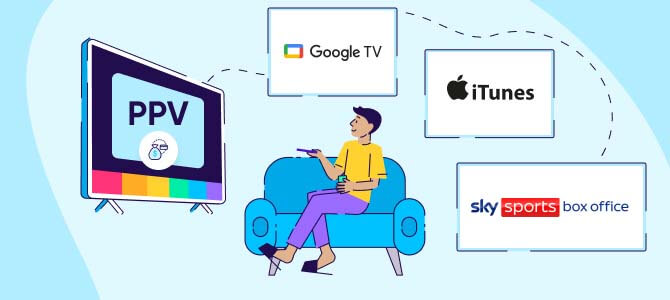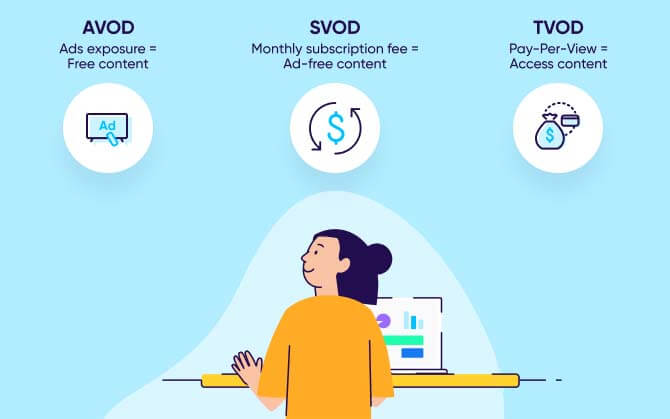TVOD (Transactional video on demand)

TVOD is a video monetization strategy that charges usage-based fees. Instead of recurring subscription payments, the viewer pays a one-time fee to view, rent, or purchase content.
What is TVOD?
Transactional video on demand (TVOD) is an OTT video monetization model that charges viewers a one-time fee to watch a piece of content.
There are three subcategories of TVOD:
- Pay-per-view (PPV): Viewers pay once to see a show, event, or broadcast on a specific channel at a set time. Broadcasters sometimes offer encore viewings, but the PPV customer usually only gets one view. This model works well for time-sensitive events like boxing matches and sports games.
- Electronic sell-through (EST): EST is a permanent electronic sale. Viewers pay once for unlimited access to specific video content, such as an e-learning course or movie.
- Download-to-rent (DTR): Viewers buy limited content access that usually lasts 24 or 48 hours from the time they start watching. OTT providers like Amazon Prime Video typically use this model.
All three TVOD types are growing quickly, with the worldwide TVOD market projected to reach almost $9 billion by the end of 2022 and nearly $13 billion by 2027.
TVOD platforms

TVOD is becoming increasingly popular on established multichannel video programming distributors such as Netflix. Streaming platforms like iTunes, Google TV, and Sky Box Office also sell and rent content using the EST and DTR models. Even eLearning platforms like Udemy offer video content access through the EST model.
Media and entertainment (movie rentals and sales) form the largest share of the TVOD market, followed by sports and online education content.
Why choose TVOD?
So, why are so many platforms turning to TVOD? Let’s take a look at some of the benefits it can bring you.
1 – Maximize revenue
Consider the revenue difference between selling access to a single piece of content on a TVOD model and offering monthly subscription fees on streaming platforms.
Renting one film on iTunes currently costs $4.99, while a monthly Netflix subscription costs $9.99. That means Apple makes about the same revenue from one user watching two movies as Netflix does from one monthly subscription to its entire catalog.
If Apple can drive as much monthly traffic to its platform as Netflix, it can expect exponentially higher revenues with the TVOD model.
2 – Monetize exclusivity
TVOD is great for monetizing major sports events, concerts, and other time-sensitive content. If you know hundreds or thousands of viewers will watch an event, it makes sense to charge per view.
TVOD can also help monetize niche content, like specialized courses and expert-authority content (for example, proprietary training material for a product your company developed in-house). If your videos are exclusively available on your site or offer something that most competitors lack, consider a TVOD monetization model.
3 – Keep out the pirates
TVOD platforms typically employ digital rights management (DRM) to protect content from piracy. DRM prevents unauthorized users from downloading your content, by requesting authentication with each download. Viewers paying for the content are automatically authenticated, letting them view content without issues.
DRM blocks any unauthenticated downloads, significantly reducing online piracy on TVOD platforms.
Potential pitfalls
Although there are lots of reasons to choose TVOD, it may not be right for everyone. It’s worth considering the following points before you commit.
1 – High viewer fees and low customer retention
The flip side of being able to charge a high fee per video is that it’s more expensive for viewers. If they can easily find your videos elsewhere, they may avoid a TVOD platform.
Likewise, paying once for a title means there’s nothing to make your viewers stay. There’s no guarantee they will return for more content, which can lead to low customer retention.
2 – Licensing issues
Ownership and licensing can become complicated under a TVOD model because viewers buy access to content, not the content itself. If the content creator later decides to remove that content from your platform, you must comply with their request.
This can lead to frustrated viewers who no longer have access to content, despite paying a one-time fee for that particular video. This exact scenario happened to both iTunes and Amazon Prime Video, resulting in lawsuits.
TVOD vs. SVOD vs. AVOD
There are three main video monetization models:
- Transactional video-on-demand (TVOD)
- Advertising-based video-on-demand (AVOD)
- Subscription video-on-demand (SVOD)
Let’s look at how they compare.
AVOD
AVOD lets viewers access video content for free, but with advertising. Popular AVOD providers include YouTube, Pluto TV, Rakuten TV, and Tubi.
AVOD is the second most popular form of video monetization after SVOD, and some predict that AVOD will soon surpass SVOD as the most popular form of video monetization.

SVOD
SVOD platforms charge an ongoing subscription for access to video content. Viewers can watch as much or as little as they want from the provider’s video library as long as they continue to pay the fee.
This is the most common type of video monetization, used by enormously successful providers such as Netflix, Amazon Prime Video, and HBO. Cable packages, subscription sites, and even premium versions of AVOD platforms like YouTube Premium all use the SVOD model.
The biggest difference between TVOD and SVOD is the ongoing fee. With TVOD, all charges are one-time. Under an SVOD model, viewers have to keep making ongoing subscription payments to access your library.
Is TVOD the right model for you?
The key to successful TVOD is exclusivity, which comes in two forms: time-sensitive and niche content. If your content includes things like live events (time-sensitive) or expert eLearning videos (niche), the TVOD model might help you generate revenue because viewers can’t easily find those videos elsewhere.
Quality first
Consider Udemy, which offers eLearning video content under an EST model. Viewers can access skills-based courses taught by real-world experts. These videos come with certificates of complet ion that viewers can use to improve their careers—unlike the free educational content readily available on platforms like YouTube. Udemy combats the potentially low customer retention rates mentioned above by providing quality and exclusive content. Considering its market cap is over $2 billion, the TVOD model seems to be working well.

Mix it up
If you’re concerned about the longevity of the TVOD model with your video content, you might consider starting with TVOD and then transitioning to another model.
Another option is to combine the TVOD and SVOD models, like Amazon Prime Video. Subscribers can access numerous free titles, but they must pay to rent or buy certain films. Viewers who don’t have a subscription can only use the TVOD model.
Whether you want to use TVOD as your main business model or combine it with SVOD or AVOD, ensure your content is compelling or exclusive enough for viewers to choose your platform over free or low-cost alternatives.
Choosing a TVOD method
Now that you’ve determined the exclusivity of your content, you should consider whether to offer videos through a PPV, DTR, or EST model.
If you stream time-sensitive content to a large audience, PPV is the best option. However, you must partner with a service that manages PPV channels, meaning some of your revenue will go to them.
DTR and EST are both ideal options for more evergreen content. You have fewer licensing risks with DTR, which also means more happy viewers—even if you have to remove a title due to legal issues. However, EST offers higher revenue per title than DTR.
Again, the bottom line when choosing between DTR and EST is exclusivity. If you think your content is exclusive enough, use EST and charge a higher rate per title. For less exclusive videos, you can use DTR or a combination of DTR and EST.
Key takeaways
- TVOD is a video monetization model that charges viewers a one-time fee to view content, whether temporarily (rental, pay-per-view) or permanently (electronic sell-through).
- There are three kinds of TVOD. Pay-per-view (PPV) charges viewers each time they want to watch a video, while download-to-rent (DTR) lets viewers access a title for a limited time. Electronic sell-through (EST) charges viewers a one-time fee for unlimited access to a piece of content.
- Unlike SVOD, TVOD does not include ongoing subscription fees. TVOD also differs from AVOD because it does not give viewers access to any content for free.
- The TVOD model is best suited for exclusive content that is time-sensitive, extremely high-quality, or only available on one platform.
- You can combine TVOD with other models like SVOD to reach a wider customer base and potentially increase revenue.


